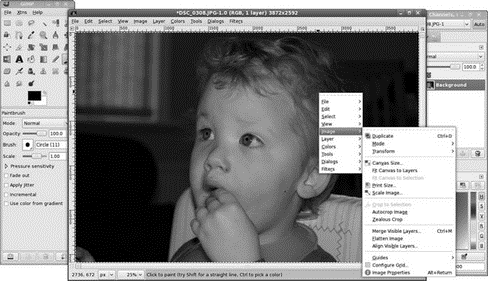Книга: Fedora™ Unleashed, 2008 edition
The GNU Image Manipulation Program
The GNU Image Manipulation Program
One of the best graphics clients available is The GIMP. The GIMP is a free, GPLed image editor with sophisticated capabilities that can import and export more than 30 different graphics formats, including files created with Adobe Photoshop. It is often compared with Photoshop, and The GIMP represents one of the GNU Projects' first significant successes. Many images in Linux were prepared with The GIMP.
The GIMP can be found under the Applications, Graphics menu as simply The GIMP.
You see an installation dialog box when The GIMP is started for the first time, and then a series of dialog boxes that display information regarding the creation and contents of a local GIMP directory. This directory can contain personal settings, preferences, external application resource files, temporary files, and symbolic links to external software tools used by the editor.
What Does Photoshop Have That Isn't in The GIMP?
Although The GIMP is powerful, it does lack two features Adobe Photoshop offers that are important to some graphics professionals.
The first of these is the capability to generate color separations for commercial press printers (CMYK for the colors cyan, magenta, yellow, and key [or black]). The GIMP uses RGB (red, green, and blue), which is great for video display, but not so great for printing presses. The second feature The GIMP lacks is the use of Pantone colors (a patented color specification) to ensure accurate color matching.
If these features are unimportant to you, The GIMP is an excellent tool. If you must use Adobe Photoshop, the current version of CodeWeavers' CrossOver Office will run Photoshop in Linux.
These deficiencies might not last long. A CMYK plug-in is in the works, and the Pantone issues are likely to be addressed in the near future as well.
After the initial configuration has finished, The GIMP's main windows and toolboxes appear. The GIMP's main window contains tools used for selecting, drawing, moving, view enlarging or reducing, airbrushing, painting, smudging, copying, filling, and selecting color. Depending on the version installed on your system, the toolbox can host more than 25 different tools.
The toolbox's File, Xtns, and Help menus are used for file operations (including sending the current image by electronic mail), image acquisition or manipulation, and documentation, respectively. If you right-click an open image window, you see the wealth of The GIMP's menus, as shown in Figure 7.5.

FIGURE 7.5 Right-click on an image window to access The GIMP's cascading menus.
- 4.4.4 The Dispatcher
- About the author
- Chapter 7. The state machine
- Appendix E. Other resources and links
- Appendix H. GNU Free Documentation License
- Appendix I. GNU General Public License
- Example NAT machine in theory
- The final stage of our NAT machine
- Compiling the user-land applications
- The conntrack entries
- Untracked connections and the raw table
- Basics of the iptables command




